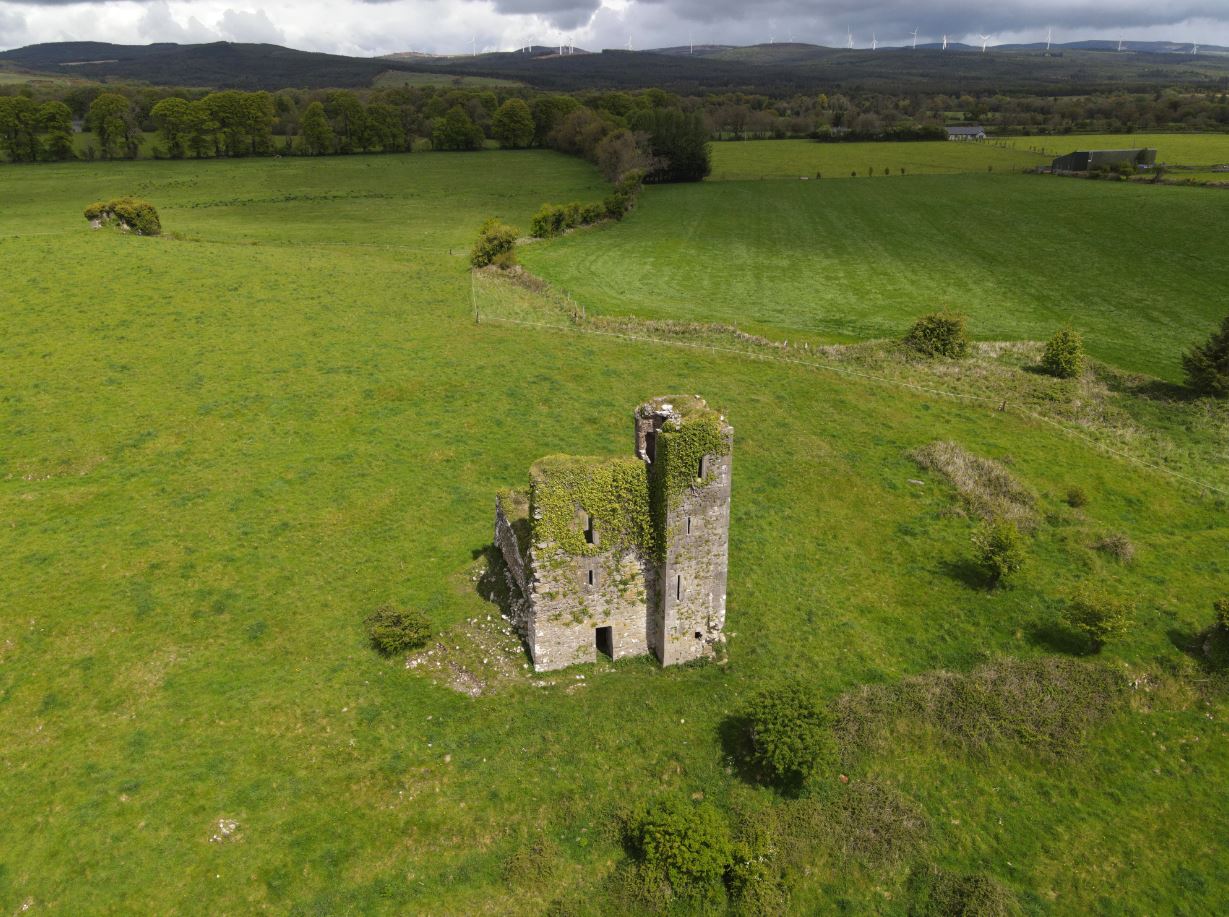1584 - the Plantation of Munster
The fallout from the Desmond Rebellion
was what would become known as the Plantation of Munster. This had been attempted on a small scale some years earlier as part of the Presidency of Munster, but with limited success, mostly due to a lack of concerted effort to attract settlers and a shortage of available land. The death of the earl of Desmond in November 1583 and the subsequent confiscation by the crown of his vast estates, now paved the way for a dramatic reform in Munster, one which was even more radical than that envisaged during the presidency in 1566. The previous Plantation of Leinster
had focused on taking Gaelic lands and redistributing them among English settlers, typically military men. The plantation of Munster would be different. Firstly, it involved the redistribution of the former estates of an Anglo-Irish earl. Secondly, the lands in question were much more extensive than those planted in Leinster. They extended throughout Cork, Kerry, Limerick and Tipperary. Thirdly, the plantation model used in Munster was somewhat different. It would be a highly structured resettlement, organised directly by the English government. It was based on a public-private partnership model and provided a template for future English plantations across the expanding British Empire. The first step was to map the region, which began in September 1584 and completed thirteen months later when it reported that there were 574,645 acres of land available for settlement. This was more than simply a mapping exercise. It was designed to calculate the various areas of land and value them, which was crucial in order to redistribute them. Furthermore, as well as a plantation in Munster, there would also be a transplantation. Ironically, the troublesome O’Mores and O’Connors of Laois and Offaly, who had already witnessed the brunt of the Leinster plantation
and, as a result, had sided with the Baltinglass Rebellion, were uprooted and brought to the southwest.
In June 1586, the scheme for the plantation was formally announced in London. The objective was to bring ‘new’ English settlers to Munster. Though the plantation scheme did allow the possibility for Anglo-Irish participation, the Gaelic-Irish were strictly prohibited from partaking. The people who were granted the Munster estates were referred to legally as undertakers, as in that they would undertake the task of the plantation. The Munster estates on offer were very large by comparison to the estates that would have been typically available on the open market in England at this time, and the undertakers were given a tempting enticement to venture to the south of Ireland. Recognising the large costs that would be incurred by the undertakers, they would be given a seven-year rent-free probationary period during which to establish themselves and their English tenants on their new Munster estates. By 1595, thirty-five successful applicants were appointed undertakers, receiving a total of close to 300,000 acres. However, the survey of the lands to be planted, carried-out between 1584 and 1585, had been hurried and, as a result, there were frequent inconsistencies with the allocations given to the undertakers. Inevitably, it resulted in numerous legal challenges between some of the undertakers themselves (for example, those who had been granted the same lands in error), or where the existing residents challenged the seizure of their lands on the grounds that they should have been exempt from the plantation. Despite this, it is estimated some 4000 new English settlers arrived in Munster during the first ten years of the plantation. Among them were two of the most famous English men of their generation, namely Sir Walter Raleigh and the poet Edmund Spenser, who are still household names today.
Walter Raleigh first came to Ireland at the outset of the Baltinglass and Desmond rebellions. In August 1580, he served as a captain with the crown forces led by Arthur Grey, Baron of Wilton that entered Glenmalure in the Wicklow Mountains, only to suffer an embarrassing defeat at the hands of Feagh McHugh O’Byrne and James fitzEustace, viscount Baltinglass. In November that year he tasted military success when Grey’s army defeated the Spanish and Italian garrison at Dún an Óir in Kerry. In 1585, Walter Raleigh was knighted by queen Elizabeth, who gave him permission to establish the first English colony in north America at Roanoke Island, off the coast of what is today North Carolina in the United States of America. He quickly sought investors to fund the new American settlement. The first colonists were dispatched in 1585, but after a harsh winter they returned for home. Among them was an artist and cartographer by the name of John White, who made water colour paintings of the native inhabitants of the island, the earliest such illustrations of the natives of the east coast of north America. The following year, Raleigh organised a fresh party of colonists, and appointed John White as their governor. This colony also struggled and White returned to England to seek further assistance for the settlers. Ironically, the first place he arrived, after a stormy return leg across the Atlantic, was Smerwick Harbour in Kerry. The threat of a Spanish invasion of England in 1588
prevented him from returning to Ranoake until two years later, by which time the colonists, including his daughter and granddaughter, had all disappeared. With no prospect of following the American dream, he moved to Cork as one of the new settlers in Munster. He leased a house and land from Hugh Cuffe, one of the plantation’s undertakers, at a small town called Newtownshandrum near Charleville in north Cork. Comprising just twenty-two houses in 1592, this was one of only six new towns established in Munster as part of the plantation.
Sir Walter Raleigh himself had not taken the dangerous voyage to Ranoake Island in 1585, though he would later visit the southern Americas. Instead, he turned his attention to Ireland once again, but this time as an entrepreneur rather than a soldier. While his Transatlantic colonists attempted their first English plantation in north America, Raleigh himself took a more direct interest in the plantation of Munster, where he had acquired over 40,000 acres in east Cork and west Waterford, stretching from the coastal town of Youghal, along the River Blackwater as far as Lismore. For a time, he resided in Youghal, and even served as mayor of the town between 1588 and 1589. As part of the plantation scheme, Raleigh was required to bring English planters to settle his vast estate in Munster. One of the most famous was Thomas Harriot, a scientist and explorer, who had accompanied John White to Ranoak Island in 1585 and appears to have been the only English man ever to have learned the language of the native islanders. In 1588, he published an account of their American expedition, and shortly later moved with his family to Molana Abbey, an Augustinian Priory on the Blackwater estuary, not far from Youghal. The priory had been closed in 1541 as part of the dissolution of the monasteries, and now formed part of Raleigh’s grand Munster estate.
One of the most renowned English poets of the 16th century was Edmund Spenser. He arrived in Ireland in 1580 as secretary to the newly appointed lord deputy, Arthur Grey, Baron of Wilton. Like Walter Raleigh, Spenser witnessed the defeat of the English army in Glenmalure and their victory at Dún an Óir. In 1582, Spenser took a lease of lands at New Abbey near Kilcullen in Kildare, which had been recently confiscated from the fitzEustace family after their part in the Baltinglass Rebellion. However, by the end of August, Grey had been recalled to England and Spenser was discharged from his secretarial post. He now needed to find new employment and took up an administrative post in Munster. By May 1589, he was granted a 3000 acres estate around Kilcolman Castle, near Doneraile in north Cork. A year later he had finished the first three (of six) parts of his epic poem The Faerie Queene, which was composed in Ireland. The poem was dedicated to queen Elizabeth, but also contains sonnets that were dedicated to his closest friends and associates, including Walter Raleigh and Arthur Grey. Indeed, it is said that Raleigh, on hearing his friend reading his poem at Kilcolman Castle, took Spenser to London to present it personally to the queen in 1590.
Spenser was a prolific writer, and in 1596 he wrote an extended essay entitled A view of the present state of Ireland. Though it was not officially published until many years after his death in 1599, it captured the mood of the new English settlers in Munster: ‘Ireland is a diseased portion of the State, it must first be cured and reformed, before it could be in a position to appreciate the good sound laws and blessings of the nation’. William Herbert from Wales had received an estate even larger than Walter Raleigh, comprising some 133,000 acres in Kerry. In 1591, he wrote a Latin essay entitled Croftus sive de Hibernia Liber, which also promoted the need for further English settlement in Ireland to rid the country of Gaelic customs and laws, though in terms of the Irish language, he did argue that the bible and common prayers should be encouraged through Irish, as a way of evangelizing the Gaelic population to Protestantism.
Spenser and Herbert’s writings personify the prejudiced Tudor English view of Ireland, but they were biased in more ways than one. Having invested significant amounts of money, time and energy into the plantation, they were keen for the English settlement in Munster to succeed, and their own enterprise would only become viable if more English settlers could be attracted to Ireland. In this respect, as least, they were not wrong. In 1598, a revolt in Ulster brought the plantation in Munster to its knees. In September that year, Edmund Spenser was appointed sheriff of Cork, but a month later his home at Kilcolman was attacked and he was forced to flee to London, where he died on 13th January 1599. Ironically, the latest revolt was led by Hugh O’Neill, the Gaelic earl of Tyrone, who for the first time in centuries created a widespread Gaelic alliance, one that would pose the greatest threat to the Tudor government in Ireland. By the time the threat had passed, Walter Raleigh had already ended his involvement in the Munster plantation and sold his Irish estates.


